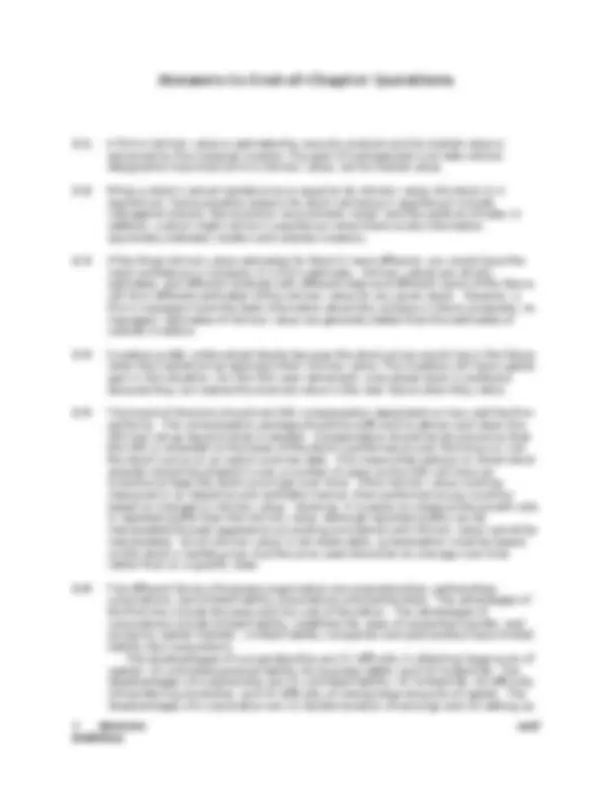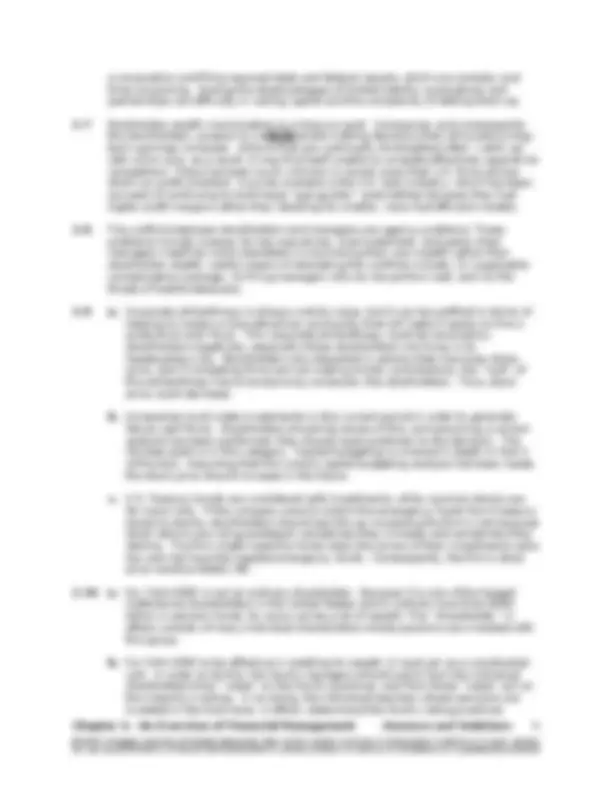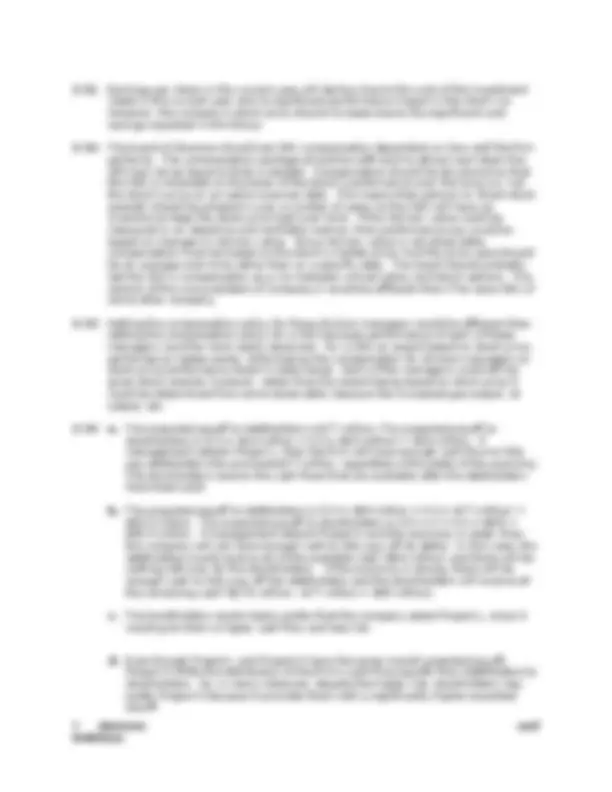





Study with the several resources on Docsity

Earn points by helping other students or get them with a premium plan


Prepare for your exams
Study with the several resources on Docsity

Earn points to download
Earn points by helping other students or get them with a premium plan
Community
Ask the community for help and clear up your study doubts
Discover the best universities in your country according to Docsity users
Free resources
Download our free guides on studying techniques, anxiety management strategies, and thesis advice from Docsity tutors
chapter 1 financial management overview solution manual to end of chapter questions.
Typology: Study Guides, Projects, Research
1 / 6

This page cannot be seen from the preview
Don't miss anything!




After reading this chapter, students should be able to:
hapter 1: An Overview of Financial Management Learning Objectives 1
Chapter 1 covers some important concepts, and discussing them in class can be interesting. However, students can read the chapter on their own, so it can be assigned but not covered in class. We spend the first day going over the syllabus and discussing grading and other mechanics relating to the course. To the extent that time permits, we talk about the topics that will be covered in the course and the structure of the book. We also discuss briefly the fact that it is assumed that managers try to maximize stock prices, but that they may have other goals, hence that it is useful to tie executive compensation to stockholder-oriented performance measures. If time permits, we think it’s worthwhile to spend at least a full day on the chapter. If not, we ask students to read it on their own, and to keep them honest, we ask one or two questions about the material on the first exam. One point we emphasize in the first class is that students should print a copy of the PowerPoint slides for each chapter covered and purchase a financial calculator immediately, and bring both to class regularly. We also put copies of the various versions of our “Brief Calculator Manual,” which in about 12 pages explains how to use the most popular calculators, in the copy center. Students will need to learn how to use their calculators before time value of money concepts are covered in Chapter 5. It is important for students to grasp these concepts early as many of the remaining chapters build on the TVM concepts. We are often asked what calculator students should buy. If they already have a financial calculator that can find IRRs, we tell them that it will do, but if they do not have one, we recommend either the HP-10BII+ or 17BII+. Please see the “Lecture Suggestions” for Chapter 5 for more on calculators.
DAYS ON CHAPTER: 1 OF 56 DAYS (50-minute periods)
a corporation and filing required state and federal reports, which are complex and time-consuming. Among the disadvantages of limited liability corporations and partnerships are difficulty in raising capital and the complexity of setting them up.
1-7 Stockholder wealth maximization is a long-run goal. Companies, and consequently the stockholders, prosper by man 0 0 1 F agement making decisions that will produce long- term earnings increases. Actions that are continually shortsighted often “catch up” with a firm and, as a result, it may find itself unable to compete effectively against its competitors. There has been much criticism in recent years that U.S. firms are too short-run profit-oriented. A prime example is the U.S. auto industry, which has been accused of continuing to build large “gas guzzler” automobiles because they had higher profit margins rather than retooling for smaller, more fuel-efficient models.
1-8 The conflicts between stockholders and managers are agency problems. These problems include overpay for top executives, overinvestment, and perks when managers might be more interested in maximizing their own wealth rather than stockholder wealth. Useful means of alleviating the conflicts include: (1) reasonable compensation package, (2) firing managers who do not perform well, and (3) the threat of hostile takeovers.
1-9 a. Corporate philanthropy is always a sticky issue, but it can be justified in terms of helping to create a more attractive community that will make it easier to hire a productive work force. This corporate philanthropy could be received by stockholders negatively, especially those stockholders not living in its headquarters city. Stockholders are interested in actions that maximize share price, and if competing firms are not making similar contributions, the “cost” of this philanthropy has to be borne by someone—the stockholders. Thus, stock price could decrease.
b. Companies must make investments in the current period in order to generate future cash flows. Stockholders should be aware of this, and assuming a correct analysis has been performed, they should react positively to the decision. The Chinese plant is in this category. Capital budgeting is covered in depth in Part 4 of the text. Assuming that the correct capital budgeting analysis has been made, the stock price should increase in the future.
c. U.S. Treasury bonds are considered safe investments, while common stocks are far more risky. If the company were to switch the emergency funds from Treasury bonds to stocks, stockholders should see this as increasing the firm’s risk because stock returns are not guaranteed—sometimes they increase and sometimes they decline. The firm might need the funds when the prices of their investments were low and not have the needed emergency funds. Consequently, the firm’s stock price would probably fall.
1-10 a. No, TIAA-CREF is not an ordinary shareholder. Because it is one of the largest institutional shareholders in the United States and it controls more than $ billion in pension funds, its voice carries a lot of weight. This “shareholder” in effect consists of many individual shareholders whose pensions are invested with this group.
b. For TIAA-CREF to be effective in wielding its weight, it must act as a coordinated unit. In order to do this, the fund’s managers should solicit from the individual shareholders their “votes” on the fund’s practices, and from those “votes” act on the majority’s wishes. In so doing, the individual teachers whose pensions are invested in the fund have, in effect, determined the fund’s voting practices.
Chapter 1: An Overview of Financial Management Answers and Solutions 4
© 2018 Cengage Learning. All Rights Reserved. May not be copied, scanned, or duplicated, in whole or in part, except for use as permitted in a license distributed with a certain product or service or otherwise on a password-protected
1-11 Earnings per share in the current year will decline due to the cost of the investment made in the current year and no significant performance impact in the short run. However, the company’s stock price should increase due to the significant cost savings expected in the future.
1-12 The board of directors should set CEO compensation dependent on how well the firm performs. The compensation package should be sufficient to attract and retain the CEO but not go beyond what is needed. Compensation should be structured so that the CEO is rewarded on the basis of the stock’s performance over the long run, not the stock’s price on an option exercise date. This means that options (or direct stock awards) should be phased in over a number of years so the CEO will have an incentive to keep the stock price high over time. If the intrinsic value could be measured in an objective and verifiable manner, then performance pay could be based on changes in intrinsic value. Since intrinsic value is not observable, compensation must be based on the stock’s market price—but the price used should be an average over time rather than on a specific date. The board should probably set the CEO’s compensation as a mix between a fixed salary and stock options. The actions of the vice president of Company X would be different than if he were CEO of some other company.
1-13 Setting the compensation policy for three division managers would be different than setting the compensation policy for a CEO because performance of each of these managers could be more easily observed. For a CEO an award based on stock price performance makes sense, while basing the compensation for division managers on stock price performance doesn’t make sense. Each of the managers could still be given stock awards; however, rather than the award being based on stock price it could be determined from some observable measure like increased gas output, oil output, etc.
1-14 a. The expected payoff to debtholders is $77 million. The expected payoff to stockholders is (0.5 × $13 million + 0.5 × $53 million) = $33 million. If management selects Project L, then the firm will have enough cash flow to fully pay debtholders the promised $77 million, regardless of the state of the economy. The stockholders receive the cash flows that are available after the debtholders have been paid.
b. The expected payoff to debtholders is (0.5 × $50 million + 0.5 × $77 million) = $63.5 million. The expected payoff to stockholders is (0.5 × 0 + 0.5 × $93) = $46.5 million. If management selects Project H and the economy is weak, then the company will not have enough cash to fully pay off its debts. In this case, the debtholders would receive all of the available cash ($50 million) and there will be nothing left over for the stockholders. If the economy is strong, there will be enough cash to fully pay off the debtholders and the stockholders will receive all the remaining cash ($170 million – $77 million = $93 million).
c. The bondholders would clearly prefer that the company select Project L, since it would give them a higher cash flow and less risk.
d. Even though Project L and Project H have the same overall expected payoff, Project H shifts the distribution of the firm’s cash flow payoffs from debtholders to stockholders. So, in many instances, despite the higher risk, stockholders may prefer Project H because it provides them with a significantly higher expected payoff.
5 Answers and Solutions